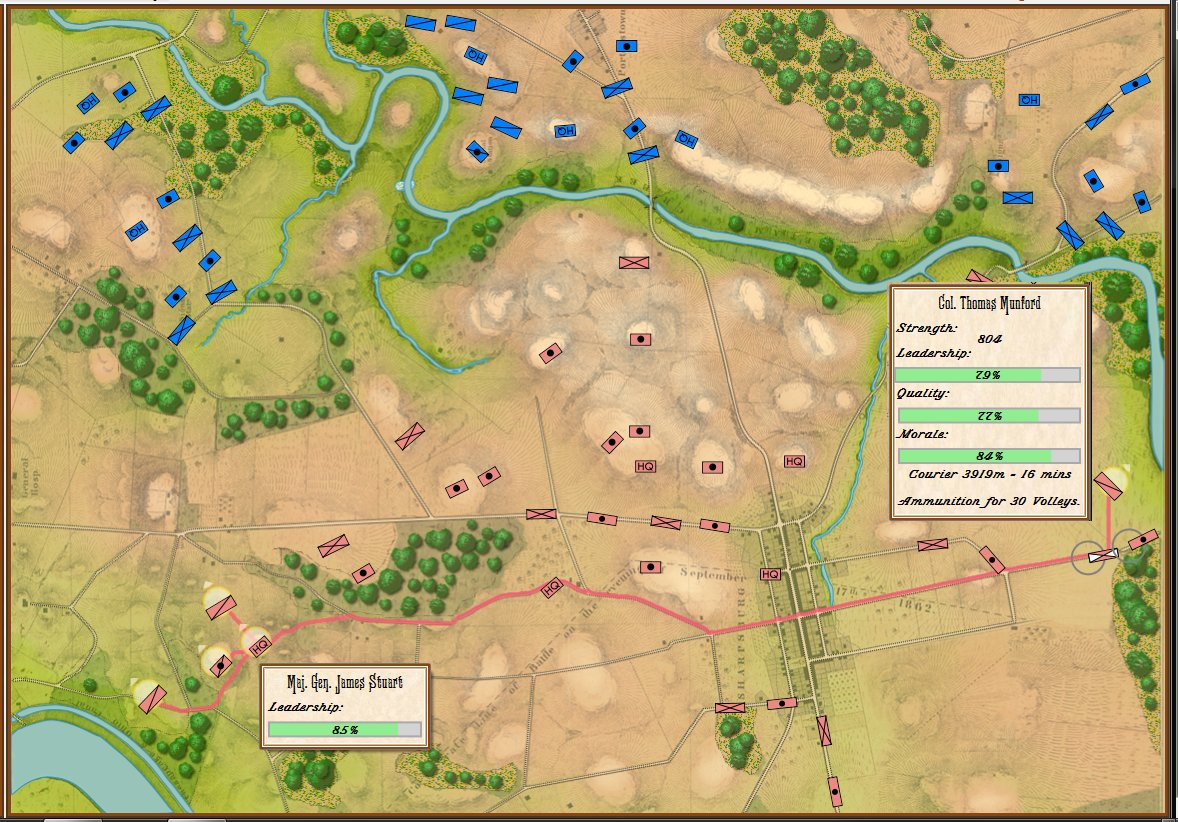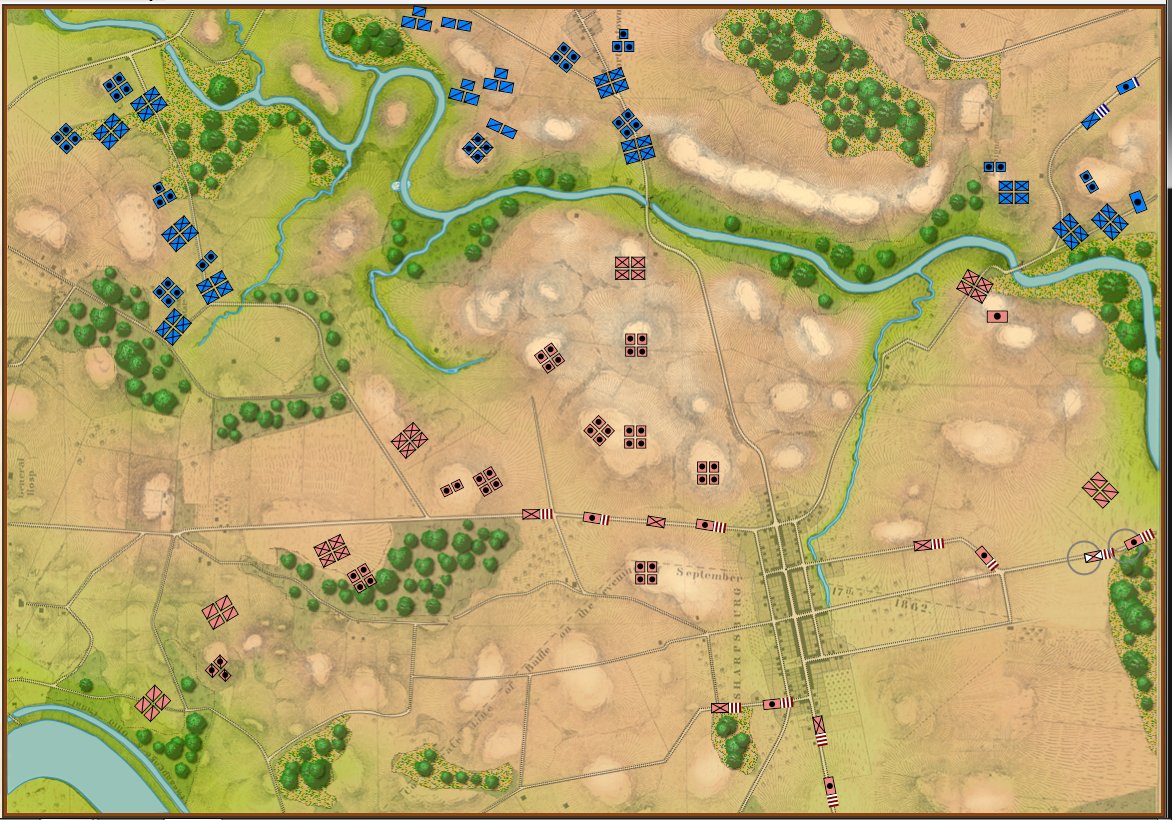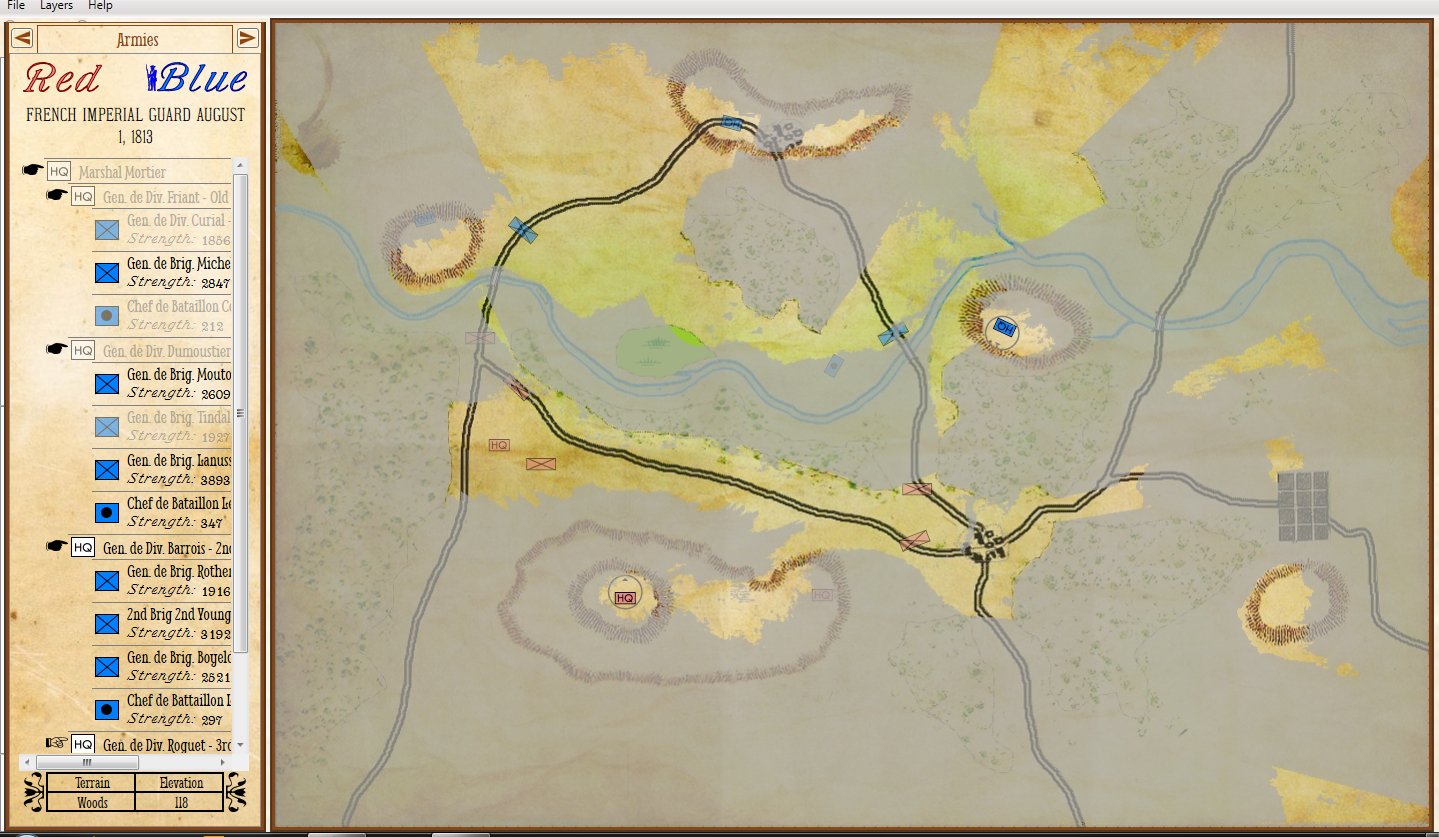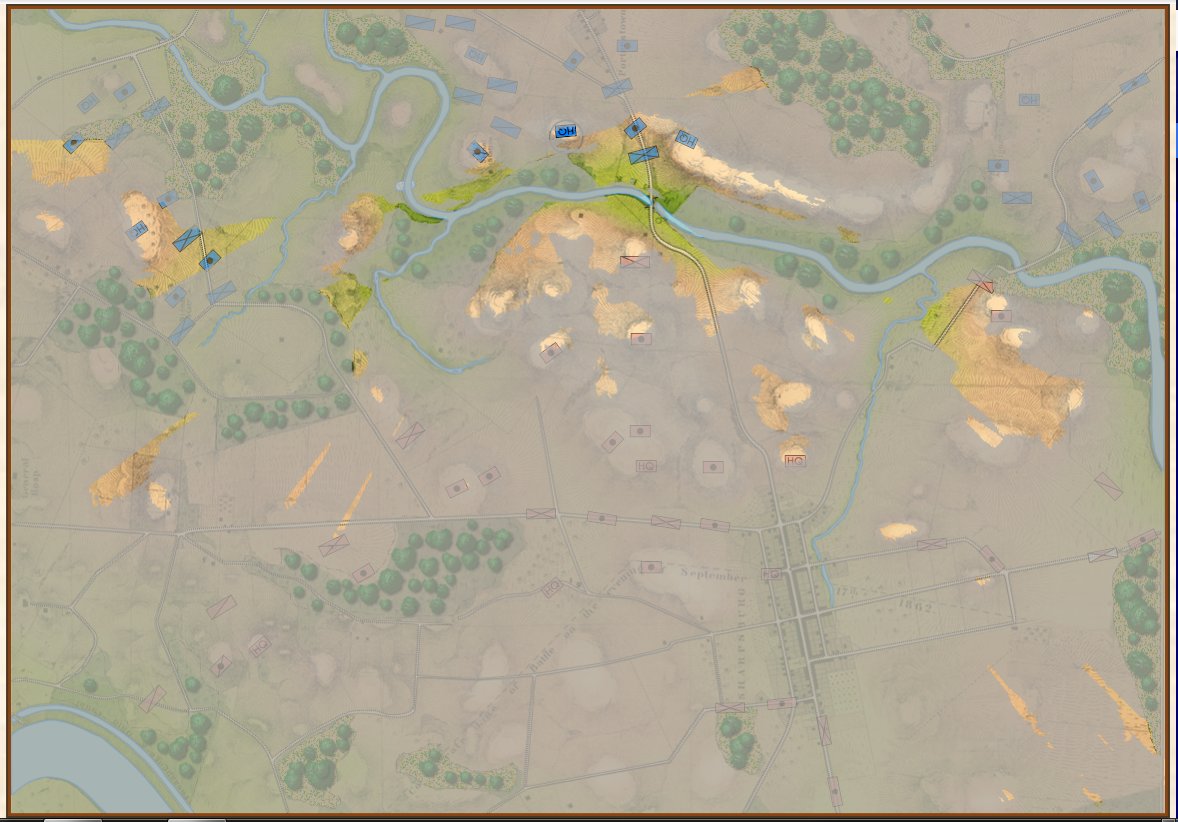Every wargame that I’ve designed allows the user to adjust important variables such as leadership and morale and how they affect combat. Usually included is the ability to design your own armies, maps and scenarios as well. However, with the General Staff Wargaming System we’ve added a new feature: the ability to control the realism level before playing a scenario.
The General Staff Wargame has two basic levels of play:
Simulation mode uses HQ units and a chain of command that passes orders down from the General HQ to the sub-commander to the individual unit. How fast the unit responds to the orders are affected by the distance that the courier must travel and the Leadership Value of the HQs. Simulation mode also employs a more detailed combat resolution model and tracks the actual number of troops in every unit.

An example of Simulation Mode: the path (red line) and time (16 minutes) it will take for a courier to travel from JEB Stuart’s HQ to Munford’s cavalry with orders. Click to enlarge.
Kriegsspiel mode does not have HQ units and friendly units are moved directly and immediately (no transmission of orders via couriers). The combat resolution model is simpler and units have a value of 1-4 displayed by the number of unit icons on the map.

Antietam in Kriegsspiel mode. Notice that there are no HQ units (so no couriers to deliver orders) and units are represented by 1-4 icons. Units in column have a ‘tail’ that indicates the unit strength. Click to enlarge.
In addition to the two game modes (Simulation and Kriegsspiel) there are three Scenario Options:
Order of Battle (OOB) displayed / not displayed. Enemy units with known positions appear dark; enemy units ‘on the map’ but with unknown locations appear grayed out. This, of course, gives the user complete knowledge of the enemy’s OOB and, more importantly, knows when units from certain formations are not directly observable.

A mock up of how the Order of Battle option will appear (note this image was created from screen captures of the Scenario Editor and the Sand Box). Click to enlarge
Only friendly units directly observed by the General HQ are displayed. All other friendly units fade at their last known location. Couriers bring in unit location updates, but they are outdated by the time they arrive.
Only enemy units directly observed by the General HQ are displayed. All other enemy units fade at their last known location. Couriers bring in unit location updates, but they are outdated by the time they arrive.
If both of these above options are selected (only friendly and enemy units that are directly observable by your commanding General HQ) you will be simulating the Fog of War that field commanders of the age of gunpowder experienced.

What General George B. McClellan could actually see at Antietam. Screen shot (General Staff Sand Box). Click to enlarge.
We would like to hear from you and get your opinion on what realism features you will use in General Staff:

I’ve only learned about this project and I’m super excited to see more!
Dr. Ezra I am just wondering if it will be possible to add multiple weapons to a unit? For example, will we be able to represent WW2/modern/futuristic warfare scenarios with units holding both anti-infantry and anti-armor weaponry? I think having as much unit customization as possible is beneficial for modelling all eras of warfare, from a scenario design perspective.
I have some good news / bad news for you. We are currently working on General Staff Black Powder; a simulation that is for 18th and 19th century battles. This will be followed with General Staff Modern Combat. And, eventually, General Staff Ancient Battles, for the pre-gunpowder era.
That’s fantastic news. I’m sure each product will be much more polished as a result of separating them out like that. Good luck with the development, and thanks for the response.
It’s also an issue with AI. Routines that are appropriate for 19th century tactics are completely wrong in modern warfare.
I would like to see the “last known” position of friendly and enemy troops with a “freshness date”.
And have those positions updated as couriers, sightings, and reports come in.
Last known locations for friendly and enemy units are displayed and they begin to fade as the information gets ‘stale’. However, we store the time, too, so there’s no reason we couldn’t also add the time (maybe make it an option).
Ezra
This is an outstanding military wargaming concept and I am very excited to see the finished product once it is finished. Very much well worth the wait and I know that you have spent a huge amount of time and effort on this “labor of love” that I am confident will be very well received.
Best wishes for a speedy conclusion.
Regards – Anthony
Colonel (Retired)
United States Army
Thank you very much! This is not my first ‘marathon’. However, encouragement is very much appreciated.
Hi Ezra, is gameplay real time or turn-based? I ask because of a time scale market I saw showing 8 seconds = 1 minute. Regarding LOS, are there instances where one of the player’s units can see one of the enemy units and NOT vice-versa? I would assume terrain would dictate something to that effect (i.e. a unit in the woods).
Every update I see makes me more and more anxious to play this game!
It is turn based with simultaneous movement; that is to say I make my moves, opponent makes moves, they’re executed simultaneously. The time for each turn is set in the Scenario Editor. Let’s see if I can post a picture… nope it will only take a URL, so I’ll write about this in a blog soon.
Mathematically, there can’t be a situation where one unit can see one unit and the other unit can’t see the first unit because of reciprocity. I suppose in real life one unit could be facing the wrong way or something. I use a 3D Bresenham line algorithm and it really doesn’t matter if we start from the observer and trace to the object or visa versa. I’ve written some blogs about this if you’re interested.
It is much more than facing the wrong way, a unit could be deployed in a forest and have eyes on an enemy unit marching in the clear. While technically that enemy unit might be able to see its opponent in the forest in reality it probably won’t. Units retreating because they are broken are less likely to spot the enemy than a unit in place and stationary.
I don’t even want to contemplate having to model such things.
Trees are an important part of the 3D LOS algorithm. Perhaps I can write a post on this if people are interested.
OOB being displayed vs not displaying.
Because of technology I think that showing the OOB is more of a quality of life issue. I.e. if I know what battle I will be playing then I can just take a peek at the opposing side’s OOB before the game starts or find some source online to get a general idea or run 2 sessions of the game. Even for altered scenarios, the person that did the alertering would still know unless you have a 3rd party doing the altering.
But if there is an option that allows for a variable OOB and/or VP condition, i.e. a 10% haircut in a side’s forces along with a decreased VP hurdle or accelerated/decelerated reinforcement schedule or no-show or what-if scenarios that allowed for the “purchasing” of units, all of which would make for interesting scenarios. Then hiding the OOB would make the fog-of-war of the enemies OOB more interesting.
Keep up the great work!
Thanks! Some time ago I was asked to prepare a proposal for IARPA (the is the Intelligence version of DARPA) and I created a game where you were Alan Pinkerton during the Civil War and it was all about trying to figure out the OOB for the Army of Northern Virginia from limited clues. Sadly, it never got made.
Hi, I like the fog of war concept. It actually never occurred to me that one could not also “see” where your one units were. Fascinating. Does this also mean the AI cannot see in a similar fashion? It does make it infinitely more challenging.
I’m really looking forward to this game. Anyway I can still get in, since I missed the kickstarter?
Yes, the AI only ‘sees’ what it should; it is also handicapped by Fog of War. Don’t get me started on games with AI that cheat! I could rant all day. Most game AI cheats. Mine never has.
Send me an email at [email protected] and you can still get in on the kickstarter.
Can the player put markers on the map to indicate the last known location of out of LOS units?
That is actually done automatically by the program. I demoed this quite a while ago when the unit pieces were larger and the interface was still under development. Here’s a link to the blog post with some screen shots: https://www.general-staff.com/general-staff-gameplay/
It’s been a while since I paid at the beginning of the kickstarter but I was excited.
I sent an e-mail about any progress but never got a reply
I was beginning to think this was a vaporware. product
could we at least have a u-tube of at least some kind of demo?
From what I see, it looks great.
P.S. i had his Amiga Version of UMS back in the day
Interesting , but what a bear to play
I think this was the 10th Update that should have gone out to all Kickstarter backers. If you haven’t been receiving them, maybe your email has changed? We also try to update this blog at least once a week. You should have also received an email about downloading the Army Editor and the Map Editor for beta testing. There are also our development blogs: http://grogheads.com/forums/index.php?topic=21270.0.
And, as always, please feel free to email me directly!
Really excited about this wargame! The UI looks clean and informative, and I love the art style.
It’ll all come down to the quality of the AI (as always with a wargame) for me.
Well, the AI is from doctoral research in tactical AI. If you’re interested I can share some published papers and my dissertation.
I will pretty much always play at the 100% level. Technically, you ought to call that level “Kreigspiel,” since what happens at 100% is what happens in an actual Kriegspiel game. Players don’t see enemy and friendly units that are out of sight, and messages come via courier.
What you’re creating is a genuine computer Kreigspiel. I’ve wanted this for a log time.
Thanks! I’ve seen a number of games called ‘Kriegsspiel’ with various visibility options. I just felt more comfortable using ‘simulation’ (probably, because of the work I’ve down for the DoD, DARPA, US Army, etc.),
Very interesting. I do want to comment that it is easy to go too far to the other side. While McClellan at Antietam could not “see” the disposition of the enemy in a fashion that is reasonably represented on a map or screen, that doesn’t mean he just didn’t know anything. Of course, it also doesn’t mean that what he “knows” is actually correct.
There are a lot of informational inputs. During the ACW, sound was often used (and often gotten wrong) to coordinate actions – as in, “Attack with your brigade when you hear the guns to your left – that will let you know we have started our attack”.
Yes, that is true. Then there’s the case of Lew Wallace at Shiloh ‘marching to the sound’ and he never actually made it to the battle!
Really never thought about not seeing friendly. Have to ponder that one.
Well, if you can directly see the unit (direct 3D LOS) then you can see the unit (friendly or enemy). Otherwise, you would be dependent on courier reports. That’s what it was like before radio & GPS. I remember Grant whittling at his HQ during the first day of the Wilderness campaign. He couldn’t see a thing. He had given his orders and was now waiting for the reports.
Wow; this is overwhelming…
I don’t know what to say!
Trying to give the user all the options they want! Most of this work (like the 3D LOS) I did some years ago as part of my DARPA work.
Hi. I’d rather get fewer options and the game faster and then get additional options in an update…
I’ve already written the Fog of War code. In fact, I did it some years ago in grad school as part of a DARPA project. I